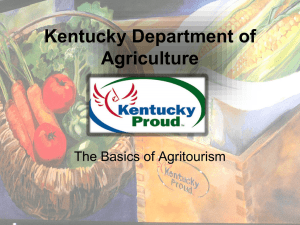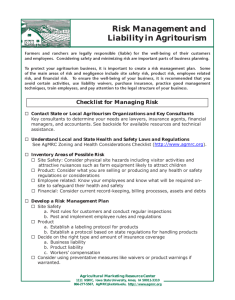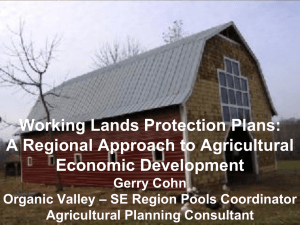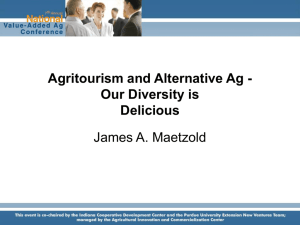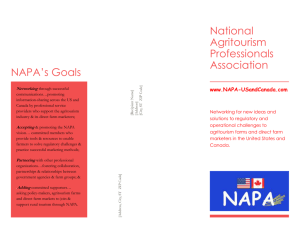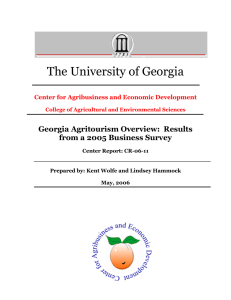Iowa Farmer Today 06-30-07 Couple’s creativity brings opportunity to their farm
advertisement
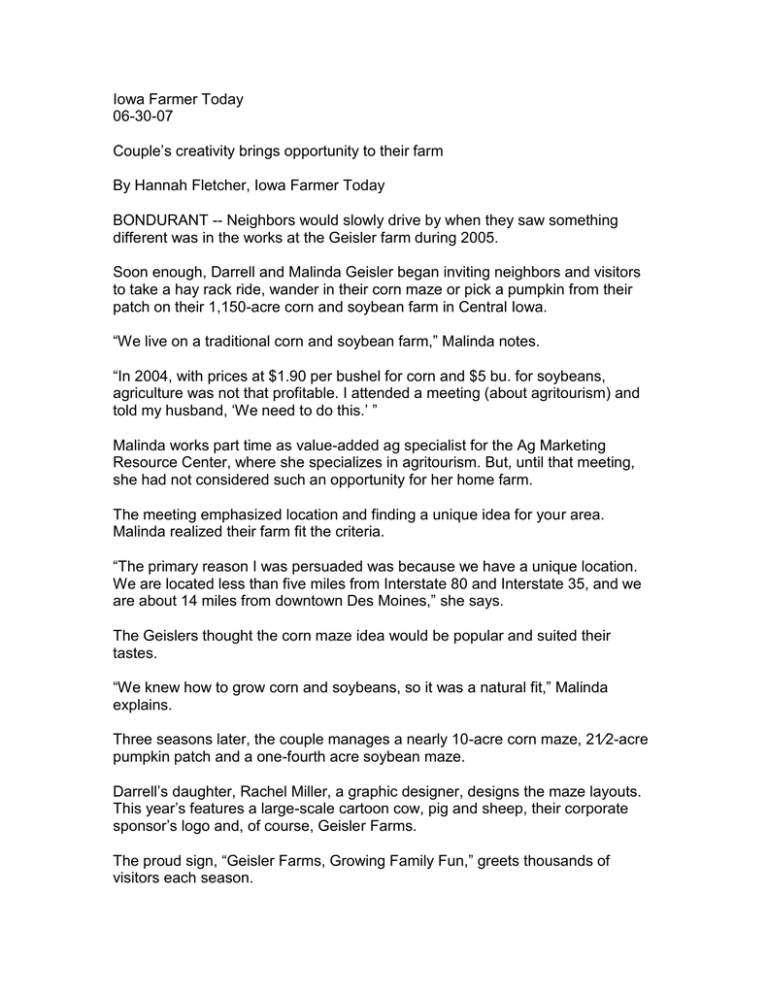
Iowa Farmer Today 06-30-07 Couple’s creativity brings opportunity to their farm By Hannah Fletcher, Iowa Farmer Today BONDURANT -- Neighbors would slowly drive by when they saw something different was in the works at the Geisler farm during 2005. Soon enough, Darrell and Malinda Geisler began inviting neighbors and visitors to take a hay rack ride, wander in their corn maze or pick a pumpkin from their patch on their 1,150-acre corn and soybean farm in Central Iowa. “We live on a traditional corn and soybean farm,” Malinda notes. “In 2004, with prices at $1.90 per bushel for corn and $5 bu. for soybeans, agriculture was not that profitable. I attended a meeting (about agritourism) and told my husband, ‘We need to do this.’ ” Malinda works part time as value-added ag specialist for the Ag Marketing Resource Center, where she specializes in agritourism. But, until that meeting, she had not considered such an opportunity for her home farm. The meeting emphasized location and finding a unique idea for your area. Malinda realized their farm fit the criteria. “The primary reason I was persuaded was because we have a unique location. We are located less than five miles from Interstate 80 and Interstate 35, and we are about 14 miles from downtown Des Moines,” she says. The Geislers thought the corn maze idea would be popular and suited their tastes. “We knew how to grow corn and soybeans, so it was a natural fit,” Malinda explains. Three seasons later, the couple manages a nearly 10-acre corn maze, 21⁄2-acre pumpkin patch and a one-fourth acre soybean maze. Darrell’s daughter, Rachel Miller, a graphic designer, designs the maze layouts. This year’s features a large-scale cartoon cow, pig and sheep, their corporate sponsor’s logo and, of course, Geisler Farms. The proud sign, “Geisler Farms, Growing Family Fun,” greets thousands of visitors each season. Visitors on the Geisler farm continues to grow just as interest in agritourism events and opportunities expands across the state. According to the Iowa Travel Industry Association, tourism-generated expenditures have increased each year from 2001 to 2005, from $4.2 billion to $5.4 billion. Many people are looking for opportunities to escape to the country, says Pat Paustian, executive director for the Iowa Ag Innovation Center. “There are less people who have family out on the farm that they can go out and visit,” she says. “People live in town where they have to go out of town to see the country and show the kids. They want things to do with children on the weekends.” Not only are tourists interested in agritourism trends, but many farmers, such as the Geislers, are anxious for the opportunity to diversify, add revenue and keep family members involved with the farm, Paustian says. “(Agritourism) is an important part of value-added agriculture,” she says. Last year, Webster’s dictionary recognized the word agritourism. It defines it as “a style of vacation in which hospitality is offered on farms.” “There are a lot of different ways (farmers) can go. It depends on what the farmers and their families want to do,” Paustian says. Enterprises may include U-pick fruit or vegetables, Christmas tree farms, wineries, country bed and breakfasts, fishing and hunting for a fee, rural weddings and many others. Although many ventures are designed for fun, Paustian says jumping into agritourism deserves thorough consideration. “It takes a lot of management and coordination, and you still have to have time to farm,” she says. Last year, Iowa State University pulled together various organizations to from the Iowa Agritourism Working Group. The group recently conducted an online producer survey to identify needs. Based on the findings, the group will compile agritourism tools and resources needed for producers. The Geislers say they “couldn’t do enough research” before launching Growing Family Fun. They attended an agritourism conference on the East Coast and talked with veterans. Connections with veterans proved valuable after a hail and thunderstorm wiped out their pumpkin patch their first season. They purchased pumpkins from a friend who runs an operation in another county to stay open. Despite that pitfall, they turned a profit the first year and learn lessons with each season. The Geislers learned agritourism is harder than it might look. Although their tour season is only in September and October, managing the agritourism elements is a year-round duty. “It looks so easy from the outside, but it is very labor intensive. We try to do most of the labor ourselves,” Darrell says. Although tour season coincides with busy harvest time, the Geislers make agritourism a priority, turning off the combine to cater to their guests. “When I’m not farming I’m working on agritourism. When I’m not doing that, I’m farming,” Darrell says. “And, we go round and round.” Their commitment is worthwhile when they see their guests enjoying themselves, they say. They have hosted people with no farm background, and many guests from other states. “They are usually in town for something else or to visit family, and they need something to do, and they choose to visit a farm,” Malinda says. “We have hosted people who have never seen corn before.” The Geislers enjoy the educational opportunity, all the while knowing they are adding revenue to their farm. They say this was part of a natural evolution. “The farm is going to evolve anyway. Darrell’s parents had livestock. Then, he focused on growing corn and soybeans. “For us, it was agritourism,” Malinda says.

